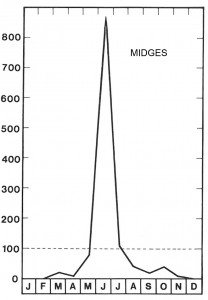
The biting midgets are tiny. At only 1-3 mm long, the gray midges (Ceratopogonidae) are the smallest blood-sucking midges. The most troublesome belong to the genus Culicoides, which includes more than 1000 species and can be found in most parts of the globe. Most species of the Culicoides have wings with dark and light spots.
Biting midges lay their eggs in moist places. The larvae live in peat moss, in moist soil or in mud. Here, they eat decomposing organic matter. Some species prefer mud soaked in salt water and are found in salt marshes. In Denmark, there is one generation of biting midges each year. The larvae overwinter, and the first adult midges take off in late April. They can be a nuisance until October. The species that particularly like humans are active at dusk. In muggy and cloudy weather, they also bite during the daytime.

Adult midges rarely move more than a few hundred meters away from its hatching place, but the wind can take it far away. Consequently, midges are a local problem near marshes, rivers or beach meadows. Midges mostly attack outdoors, but some species can get into living rooms or stables and bite humans and pets.




